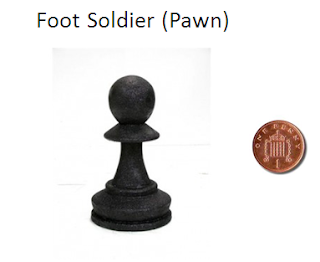TIP 1: Ignore false threats (if an enemy piece threatens your piece but your
piece is already guarded in such a way that if the enemy DID take it
then it would be taken back)
TIP 2: To take is a mistake (if the enemy initiates - i.e. a sacrifice or trade - as this helps to activate THEIR pieces! only take if you have initiated the attack)
TIP 3: Think prophylactically at least 2 moves ahead (know what your enemy's intention is for every move they make - if it is not making a threat, then it may be moving into position to make one) - and then prevent this in advance (perhaps by placing a defender on a key square so that if they moved there NOW they would be taken - this is the secret to positional play - so only use this when getting into position (lest you be defeated by a truely tactical player). Use tip 4 when you are about to engage or are being engaged.
TIP 4: Tactics: the best way to employ tactics are to find an end (it could be an endgame position OR one of the following strong attacks on a piece: fork, double attack, discovered attack, trap). Once you've spotted the potential to apply one of these, then look at what is stopping you doing this (i.e. the enemy has defended a key square, etc). Now see if you can overcome these obstacles with any of the following tactics (Check, Pin, Sacrifice: to Remove defender, Clear a Square or Block a Square & Superior Concentration of forces) - What? you can use one of these but it doesnt help you to reach your goal? then use it a second time! i.e. Sacrifice to clear a square, then pin a piece, NOW you can do your attack. Use the "check, pin, sac" as many times in a row as you can in order to setup your attack (the more you use - the harder it will be for your opponent to see). To remember all that use the acronym: "CHECK.PIN.SAC (RE.CLEAR.BLOCK.) CON --> FOR.DOUBLE.DISCOVERED.TRAP"
TIP 5: Once ahead in material, reduce (an enemy bishop for your knight, etc), this reduces your enemies possibilities for tactics and getting ahead and also increases your advantage (2:3 is greater than 3:4)!
TIP 2: To take is a mistake (if the enemy initiates - i.e. a sacrifice or trade - as this helps to activate THEIR pieces! only take if you have initiated the attack)
TIP 3: Think prophylactically at least 2 moves ahead (know what your enemy's intention is for every move they make - if it is not making a threat, then it may be moving into position to make one) - and then prevent this in advance (perhaps by placing a defender on a key square so that if they moved there NOW they would be taken - this is the secret to positional play - so only use this when getting into position (lest you be defeated by a truely tactical player). Use tip 4 when you are about to engage or are being engaged.
TIP 4: Tactics: the best way to employ tactics are to find an end (it could be an endgame position OR one of the following strong attacks on a piece: fork, double attack, discovered attack, trap). Once you've spotted the potential to apply one of these, then look at what is stopping you doing this (i.e. the enemy has defended a key square, etc). Now see if you can overcome these obstacles with any of the following tactics (Check, Pin, Sacrifice: to Remove defender, Clear a Square or Block a Square & Superior Concentration of forces) - What? you can use one of these but it doesnt help you to reach your goal? then use it a second time! i.e. Sacrifice to clear a square, then pin a piece, NOW you can do your attack. Use the "check, pin, sac" as many times in a row as you can in order to setup your attack (the more you use - the harder it will be for your opponent to see). To remember all that use the acronym: "CHECK.PIN.SAC (RE.CLEAR.BLOCK.) CON --> FOR.DOUBLE.DISCOVERED.TRAP"
TIP 5: Once ahead in material, reduce (an enemy bishop for your knight, etc), this reduces your enemies possibilities for tactics and getting ahead and also increases your advantage (2:3 is greater than 3:4)!












